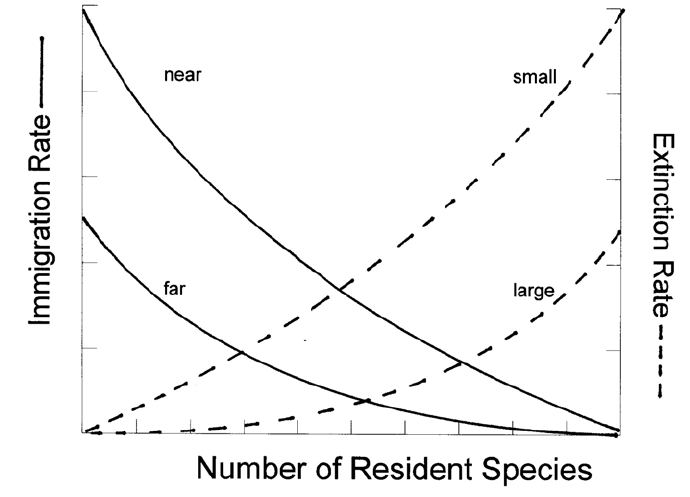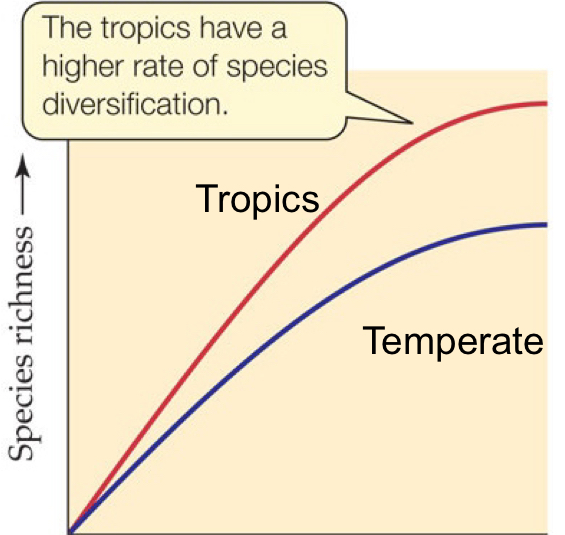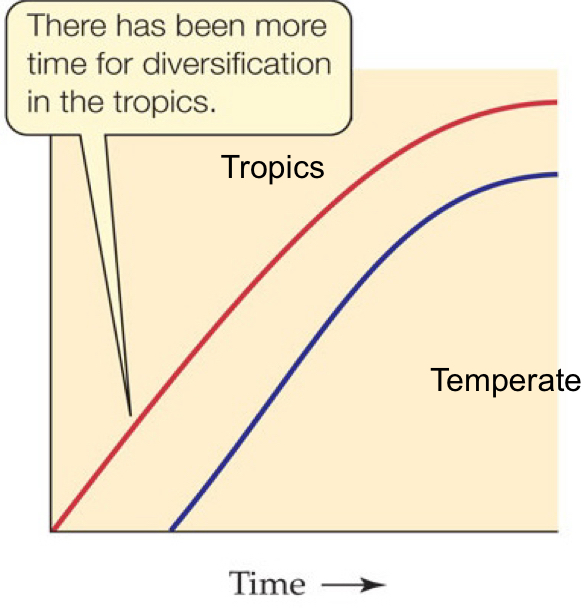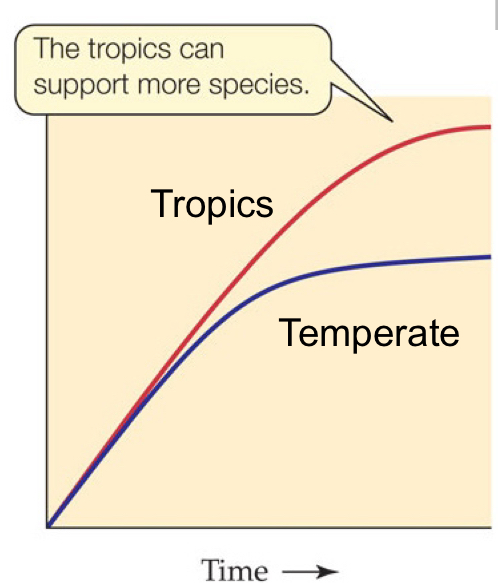Biogeography
1/23
There's no tags or description
Looks like no tags are added yet.
Name | Mastery | Learn | Test | Matching | Spaced |
|---|
No study sessions yet.
24 Terms
What are the scales of biodiversity?
Global scale → Earth
Regional scale → North America or Mid-Atlantic
Landscape scale → Virginia
Local scale → Charlottesville
What are the types of biodiversity?
Gamma diversity → all of the species in a region, driven by speciation, extinction, dispersal
Alpha diversity → essentially a community; determined by local conditions and interactions; subset of Gamma diversity
Beta diversity → turnover (difference) of species from one community to another within a landscape
How are communities structured?
By regional and local processes; the regional species pool is the raw material for local communities and sets the upper limit for local diversity
How do you read local richness curves?
slope = 1 → all species in the region are found in every local community
slope < 1 → local richness increases proportionally, meaning regional processes still dominate
flat/diminishing returns slope → local richness does not increase with regional richness; local processes dominate richness
How does regional richness determine local richness for marine invertebrate communities?
Regional processes explain 75% of variation among communities; the slope is < 1 so regional processes dominate, meaning there are more species in communities that are in regions with higher richness, but it is still not a 1:1 ratio
How are area and distance related in regional biogeography for islands?
They are confounded → bigger islands are closer (smaller distance) and smaller islands are farther (larger distance)
What is the Equilibrium Theory of Island Biogeography?
It states that species number doubles with a 10x increase in island size and as new species colonize an island, there is no net increase in species richness because new immigrants replace old species; this leads to the conclusion that there is an equilibrium number of species on an island that depends upon size and distance from a source (mainland); the composition of the community may change over time, but the equilibrium number of species is fixed
How does island distance determine immigration rate in Island Biogeography?
Near islands have higher immigration rates (receive more immigrants) than far islands because they are closer to source (mainland); immigration rate declines as the number of species on the island increases because there are fewer open niches
How does island size determine extinction rate in island biogeography?
Smaller islands have a higher extinction rate than larger islands because smaller islands cannot support as many species as larger islands; as species number increases, extinction rate increase because there is more competition/predation
Where do we find the equilibrium number of species using immigration and extinction curves?
We predict the equilibrium number of species to be where the immigration and extinction curves intersect, meaning the number of species going extinct is equal to the number immigrating; species identity may change, but total number remains at equilibrium

At equilibrium, will a smaller island or larger island have more species, assuming distance is equal?
A larger island will have more species because it intersects the immigration line at a higher species number

At equilibrium, will a near or far island have more species, assuming size is equal?
A near island will have more species because it intersects the extinction line at a higher species number
What size and distance island will have the largest turnover rate (change identity of species the most)?
A small near island because it has the highest extinction rate and the highest immigration rate
What does turnover refer to?
The change in the number of species in a community/region
How do clades in the southern hemisphere relate to clades in the northern hemisphere?
Clades in the southern hemisphere (South America, Africa, Australia, India) are more closely related to each other than they are to clades in the northern hemisphere (North America, Europe, Asia) despite distance
Why are clades in the southern hemisphere more closely related to each other than to clades in northern hemsiphere?
Because when Pangea broke apart, it broke into Laurasia, which included the northern hemisphere continents (North America, Europe, Asia) and Gondwana, which included the southern hemisphere continents (South America, Africa, Australia, and India)
How are regional biota determined?
By shared evolutionary history more than physical proximity
Are India and Africa or India and Asia predicted to have the most phylogenetically similar groups of species?
India and Africa because they were in Gondwana together, whereas Asia was in Laurasia
Where do we find the most species richness by latitude?
There is more species richness at lower latitudes, with the most species richness found at the equator (latitude of 0)
What are biodiversity hotspots?
Areas where longitudinal patterns overlay latitudinal patterns of diversity, create areas of very high biodiversity; these hotspots contain tons of diversity (44% of plants and 35% of vertebrates), yet only cover about 1.4% of the landmass
What are 3 hypotheses for why there are more species in the tropics?
Diversification Rate → more species are generated in the tropics; slope of species richness for tropics is higher than slope of species richness for temperate zones
Diversification Time → the tropics had a longer time to generate species, so the slope of species richness is the same but the start time is different
Productivity of carrying capacity → the tropics have higher carrying capacities than temperate zones, so the plateau of species richness is higher up in the topics than in temperate zones

What is the Diversification Rate hypothesis for species richness in the tropics?
More species are generated in the tropics; slope of species richness for tropics is higher than slope of species richness for temperate zones; land area and thermal stability are greater in the tropics, which should lead to larger populations, lower extinction rates, and broader geographic ranges

What is the Diversification Time hypothesis for species richness in the tropics?
The tropics had a longer time to generate species, so the slope of species richness is the same but the start time is different; tropics have been more climatically stable over geological time so they’ve had more uninterrupted time to accumulate species; the tropics serve as a cradle and a museum of species diversity, meaning major clades originated in the tropics and spread toward the poles

What is the Productivity hypothesis of species richness in the tropics?
The tropics have higher carrying capacities than temperate zones, so the plateau of species richness is higher up in the topics than in temperate zones; there is more sun, so more input into the base of the food web pyramid, so there is more productivity (more species)